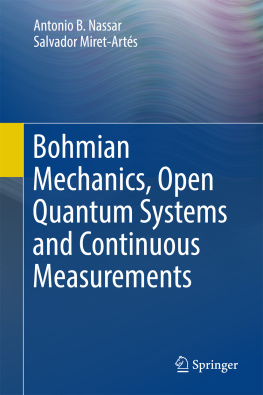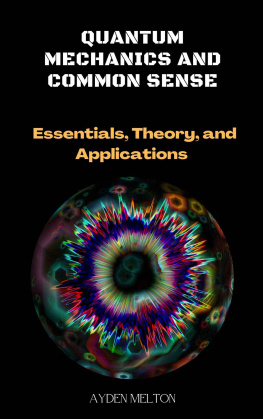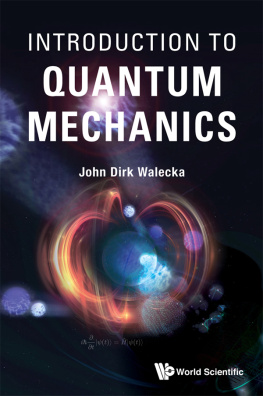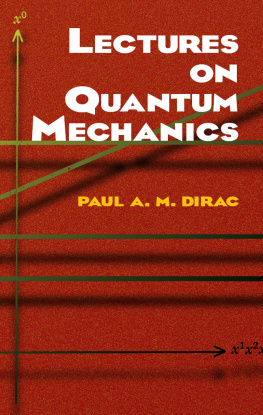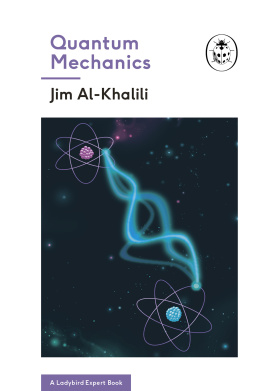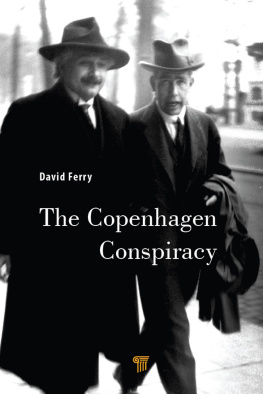1. Historical and Introductory Account of Bohmian Mechanics
1.1 Introduction
John Bell was a theoretical physicist famous for his results in the field of foundations of quantum mechanics [].
Bell championed the theory put forth by de Broglie in 1927 and advanced by David Bohm in 1952 [].
In the simplest pilot-wave theory, Bohmian mechanics, paradoxes of quantum mechanics can be resolved in a simple way while the particles have positions, they move according to Schrdingers equation. For example, one of the most famous paradoxes (in the standard interpretation) at the heart of quantum mechanics is the double-slit experiment. By using the concept of weak-value measurements introduced originally by Aharanov et al. [].
Bohmian mechanics allows us to understand and explain quantum systems in terms of the motion displayed (in configuration space) by a swarm of quantum trajectories. Each one of these trajectories represents the evolution in time of a particular initial state specified by a point on the configuration space associated with the system. Thus, unlike standard quantum mechanics, where the wave function determines the state of the system on the whole available configuration space, in Bohmian mechanics it is possible to follow one particular point of such a space. The time-evolution of this point is given according to some prescribed quantum laws of motion. The evolution of the trajectory ensemble is equivalent to the evolution of a quantum flow this is precisely the viewpoint of quantum hydrodynamics. The Bohmian view does not invalidate at all other ways of understanding quantum systems; it only allows us to think of them on similar grounds as classical ones, i.e., using a similar intuitive scheme, which differs from a purely classical one precisely in the types of motion one can observe. However, unlike any classical approach to quantum mechanics, Bohmian mechanics is not an approximated theory, but an exact one. Furthermore, by looking at one of those diffraction experiments carried out with electrons [].
The problem of many-body interactions or, equivalently, many degrees of freedom can be tackled from different points of view, since it appears in many different physical, chemical and biological contexts. For example, quantum chemistry constitutes nowadays one major field in importance and interest. In order to carry out the large-scale calculations and simulations, an increasing computational capacity of modern computers is critical. The corresponding theoretical analysis relies on considering the so-called Born-Oppenheimer approximation , which allows us to simplify the study of any molecular system (simple molecules, solid surfaces, polymeric chains, clusters, crystalline structures, etc.) by splitting it into its electronic and nuclear parts. By solving the Schrdinger equation associated with the electronic Hamiltonian, which is the ultimate goal of electronic structure methods, one determines electronic configuration of a (multi-electron) system, i.e., the way how electrons distribute throughout such a system. This knowledge will essentially determine its chemical properties, e.g., chemical bonding, intermolecular interactions, electronic charge distributions, dipole and multipole moments, or vibrational/rotational frequencies. Nonadiabatic problems have also been tackled within the Bohmian complex formalism [].
When the dimensionality of the problem considered increases, as happens with many systems of quantum chemistry and solid state physics, computational problems increase and start becoming unaffordable. To overcome this drawback, a series of approaches based on the density matrix theory [] and therefore the validity of this approach is conditioned to its ability to provide results sufficiently close to the experimental data.
Standard DFT is commonly applied to determine ground states in time-independent problems. However, its time-dependent generalization, the so-called time-dependent DFT (TD-DFT), are needed when processes and phenomena are intrinsically time-dependent [], these weak measurements are not other thing that standard transition probabilities within the Bohmian scenario, i.e., just a particular type of equation of change, according to Hirschfelder.
On the other hand, strictly speaking, real physical systems do not exist in complete isolation in nature. All physical systems are open systems in the sense that the interaction with their environments can never be totally neglected. From its inception, the motion of particles in quantum mechanics was thought to happen in the presence of an environment and could be understood in terms of a stochastic process. In fact, a formal analogy between the Brownian motion and the Schrdinger equation was noticed by Frth [] have recently extended Bells beables to encompass dissipation, decoherence and the quantum-to-classical transition through quantum trajectories.
Concurrently, Nelson and de la Pea opened up an alternative route for deriving generalized nonlinear Schrdinger equations. Within the quantum hydrodynamical framework, Nassar [].
The theory of open quantum systems has also been developed by different routes from the very beginning leading to different stochastic derivations of the Schrdinger equation. Traditionally, the so-called system-plus-reservoir methods are being largely used in this context, working either in the Schrdinger picture (density matrix formalism) or the Heisenberg picture of quantum mechanics (quantum Langevin equation). The reader interested in these different alternatives can look at, for example, Refs. []. In this context, the terminology of quantum trajectory is also used but it should not be confused with the corresponding Bohmian trajectory. When dealing with open quantum systems within the Bohmian formalism in the following chapters, these trajectories will be handled with care.
Dealing with measurements, the physical system to be measured together with the apparatus can also be considered as an open system []. After Bohr, one cannot separate the behavior of the quantum objects from their interaction with the instruments. However, the key concept in this mechanics is the concept of a quantum state along the lines initiated by Dirac and von Neumann. After Dirac, each physical quantity is represented by an Hermitian operator which is called an observable. When this property is measured by an apparatus, the system is left with a wave function corresponding to an eigenfunction of this observable. Afterwards, we can measure the same observable again and again with the same result that the wave function does not change significantly (except for a phase factor). After von Neumann, the wave function provides the most complete possible description of what he called quantum reality (no further concepts, e.g., involving hidden variable could be introduced that would make possible a more detailed description of the state of the system than is afforded by the wave function). In 1955, von Neumann proposed to divide the world into two parts: an observed system and a system that may observe, say a meter or a pointer. In other words, he was led to make a distinction between the quantum and classical levels. Between them, he said there was a cut or a dividing line . The location of the cut is to a large extent arbitrary. The apparatus must combine quantum and classical properties. The Schrdinger equation can not map a pure state into a mixture, or better said, a proper mixture killing the interference terms. Von Neumann also proposed a different evolution, discontinuous, noncausal and nonunitary, the so-called projection postulate or the hypothesis of wave function collapse or reduction which is an irreversible process and takes place instantaneously. Thus, the many-body Schrdinger theory is no longer applicable in the measuring process and this implies a massive incompleteness in the quantum mechanical treatment. No one knows when the collapse is supposed to occur, how long it takes or what brings it about. This process of reduction or collapse of the wave function is the simplest example of decoherence or conversion of a superposition state into one of the eigenstates of the observable measured with probability given by the squared modulus of the corresponding coefficient. The emergence of the classical world implies the phenomenon of decoherence, that is, the conversion of a coherent superposition of states into a mixture since superposition states are not observable. One of the components of the mixture has to be somehow selected to lead to a definite measurement readout. In other words, the measuring process is the selection of one out of many alternatives. Irreversibility is then settled.

